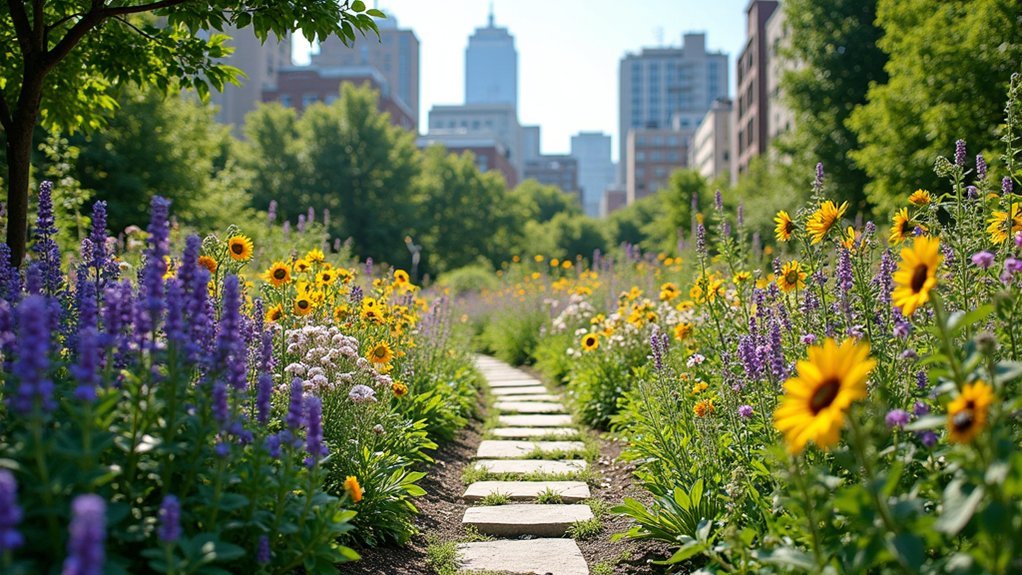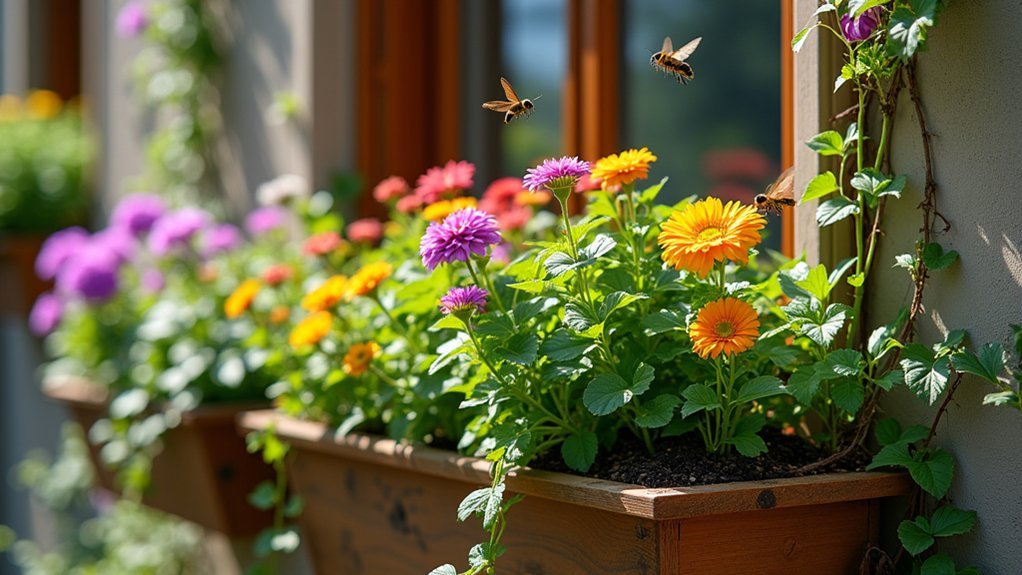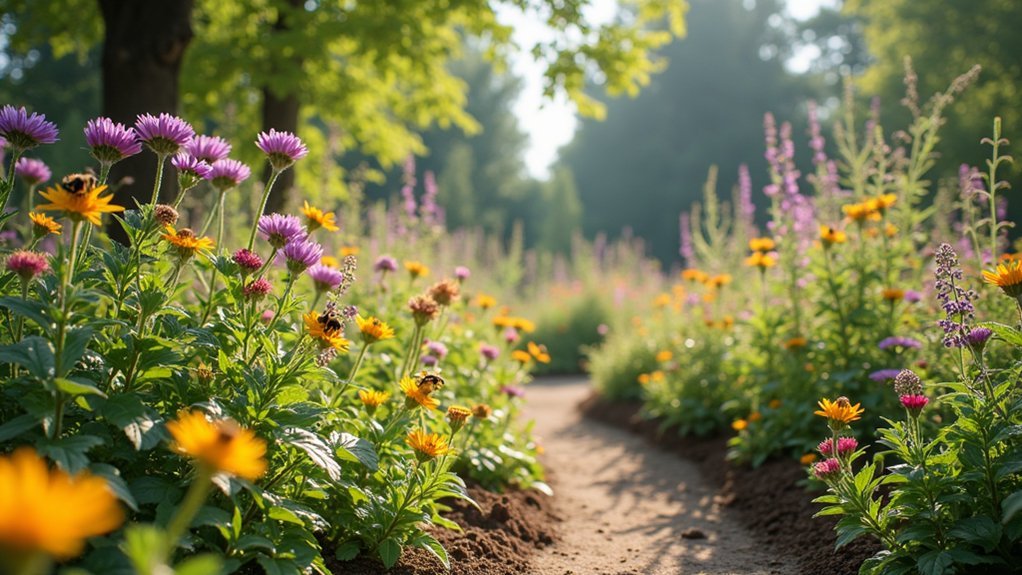City gardens create essential bridges between isolated green spaces in urban landscapes, allowing pollinators to navigate and find continuous nourishment. When placed within 750 meters of each other, they form effective pathways for bees, butterflies, and hummingbirds. You'll maximize impact by planting diverse native species that bloom sequentially, adding water features, and eliminating chemicals. These interconnected havens support not just honeybees but countless native pollinators vital to our food security and biodiversity.
What Makes City Gardens Perfect Pollinator Pathways?

While concrete and asphalt dominate urban landscapes, city gardens emerge as essential oases for pollinators traversing through metropolitan environments. These pollinator gardens create significant bridges between isolated green spaces, allowing bees, butterflies, and hummingbirds to navigate effectively through urban areas.
What makes them perfect? It's their strategic positioning and thoughtful design. By planting Native Plants that bloom sequentially throughout the growing season, you're providing continuous nourishment for diverse pollinator species.
Strategic placement combined with sequential blooming creates pollinator pathways that nourish our ecosystem's essential workers year-round.
Adding water features addresses urban scarcity issues that pollinators face daily.
Your garden's impact extends beyond its boundaries—it becomes part of an interconnected network supporting biodiversity. When communities collaborate to create these pathways, they're not just gardening; they're building sustainable ecosystems that benefit both wildlife and residents alike.
The Urban Pollinator Crisis: Why Cities Need Green Corridors
Beyond the beauty city gardens bring to urban spaces, they're becoming lifelines in a growing ecological emergency. As urban landscapes replace native vegetation, pollinators struggle to find resources needed for survival.
Creating habitat for pollinators through interconnected green corridors isn't just beneficial—it's crucial. When you establish pollinator pathways, you're:
- Saving the species responsible for one-third of your food supply
- Reconnecting fragmented habitats that allow bees and butterflies to navigate concrete jungles
- Joining over 200 communities already committed to urban ecological restoration
- Directly countering the alarming decline of species critical to our food security
Your garden, balcony, or windowsill can become part of this essential network, transforming isolated green spaces into corridors that sustain life throughout your city.
Connecting Fragmented Habitats: The Power of Garden Networks

Although concrete and asphalt dominate urban landscapes, strategically placed gardens create essential lifelines for pollinators traversing through cities.
You'll make a significant difference by establishing pollinator gardens within 750 meters of each other, effectively connecting fragmented habitats that bees and butterflies need to survive.
When you and your neighbors collaborate on creating these green corridors, you're building vital infrastructure for the 90% of flowering plants dependent on pollinators.
Your community's garden network doesn't just help bees—it transforms urban ecology by increasing biodiversity, supporting local food production, and creating sustainable green spaces throughout the concrete jungle.
Native Plant Selection for Maximum Pollinator Support
Your urban garden can become a pollinator powerhouse by incorporating keystone native plants like milkweed, which supports monarch butterflies and numerous other species.
You'll maximize impact by selecting natives that create a continuous bloom cycle from spring through fall, ensuring pollinators have food sources throughout their active seasons.
Even in small spaces, you can replace ornamental exotics with compact native alternatives that provide superior ecological value while thriving with less water and maintenance.
Strategic Urban Keystone Plants
While transforming city gardens into thriving pollinator havens, selecting native keystone plant species becomes the foundation of your conservation efforts.
In urban areas, these powerhouse plants support disproportionately large numbers of caterpillars and adult pollinators, creating biodiversity hotspots in otherwise concrete landscapes.
- Milkweed isn't just another native plant—it's the sole host for monarch butterflies, making it vital for their survival in your urban garden.
- Goldenrod supports over 100 butterfly and moth species while offering critical late-season nectar.
- Coneflowers provide both summer beauty and winter seed heads that feed birds long after blooming.
- Native trees and shrubs serve as ecological anchors, hosting hundreds of caterpillar species while requiring minimal maintenance.
Season-Long Bloom Cycles
Creating a continuous succession of blooms stands as perhaps the most essential strategy for supporting urban pollinators throughout their active seasons. Your garden should feature native plants that flower at different times, guaranteeing nectar and pollen are always available from early spring through late fall.
Select native plants that naturally thrive in your local conditions rather than modern hybrids, which often lack the nutrients and fragrance pollinators need.
Plant in clusters to improve foraging efficiency—pollinators expend less energy when flowers are grouped together.
Incorporate keystone species like milkweed and coneflowers to support specific caterpillar species and significant lifecycle needs.
By designing your garden with season-long bloom cycles in mind, you'll create important pollinator pathways in urban environments.
This thoughtful approach to planting guarantees your city garden becomes a sustainable sanctuary where diverse pollinator species can flourish year-round.
Small-Space Native Alternatives
Many urban gardeners believe a small plot limits their pollinator support potential—nothing could be further from the truth.
You can transform even the tiniest balcony or patio into a thriving pollinator pathway by strategically selecting native plants that maximize ecological impact in minimal space.
Aim for at least 70% native plant coverage and choose compact varieties like prairie smoke and dwarf bluebell that:
- Create season-long food sources from early spring through late fall
- Include keystone species like milkweed and coneflower that attract pollinators in impressive numbers
- Offer specialized habitat that modern hybrids simply can't provide
- Connect fragmented urban ecosystems, creating essential "stepping stones" for pollinator movement
Beyond Honeybees: Diverse Pollinators in Urban Ecosystems
When planning your urban garden, you'll help more than just honeybees—native mason bees, leafcutter bees, and hundreds of other solitary species desperately need your city spaces to survive.
These overlooked insect heroes can pollinate up to 80% more effectively than honeybees, yet they're often forgotten in conservation conversations.
Your plant choices matter tremendously, as diverse flowering species guarantee year-round resources for different pollinators, creating stepping stones that connect otherwise fragmented urban habitats.
Overlooked Urban Insect Heroes
Beyond the familiar honeybee, five remarkable groups of insect pollinators quietly sustain our urban ecosystems.
Native bees, including mason and leafcutter species, often outperform honeybees when pollinating specific plants in your neighborhood. These unsung heroes form the backbone of urban Pollinator Pathways, connecting fragmented green spaces across the concrete landscape.
You'll find these incredible creatures working tirelessly in your community gardens:
- Solitary bees – These efficient pollinators visit more flowers per minute than honeybees.
- Butterflies – Not just beautiful, but critical pollinators for many native flowering plants.
- Pollinator flies – Often overlooked despite being second only to bees in pollination importance.
- Beetles – Ancient pollinators that support biodiversity in urban ecosystems.
Native Bees Need Cities
Contrary to popular belief, your urban landscape provides essential habitat for native bees. These important pollinators often thrive in city environments where thoughtful gardens create sanctuaries amid concrete expanses. Native bees have specific requirements that urban gardens can fulfill perfectly.
| Native Bee Type | Urban Nesting Preference | Garden Plants They Love |
|---|---|---|
| Mason Bees | Hollow stems, wood blocks | Spring fruit blossoms |
| Leafcutter Bees | Soft leaf material | Summer vegetables |
| Mining Bees | Bare soil patches | Native wildflowers |
| Bumblebees | Ground cavities, compost | Herbs, berries |
City gardens create essential corridors that connect fragmented habitats, allowing native bees to navigate between resources. Research confirms that urban areas with diverse native plantings greatly boost local bee populations, transforming your garden into a significant link in the pollinator pathway.
Floral Diversity Matters
Although honeybees often capture public attention, they represent just a fraction of the pollinator community that thrives in urban environments.
Your garden can support mason bees, leafcutter bees, butterflies, and hummingbirds when you prioritize diverse native plants.
Research confirms that urban spaces with varied flora attract more pollinator species.
When you're planning your garden, consider these emotional benefits:
- Joy – Witnessing a rare butterfly visit your carefully selected blooms
- Pride – Creating a haven that supports endangered pollinator species
- Wonder – Observing different pollinators' unique behaviors throughout seasons
- Connection – Contributing meaningfully to your local ecosystem's health
Remember to include plants that bloom in different seasons, ensuring continuous nectar sources year-round for your diverse pollinator visitors.
Seasonal Planning for Year-Round Pollinator Resources
When designing a city garden that truly benefits pollinators, you'll need to think beyond a single growing season.
Creating pollinator friendly spaces requires strategic selection of plants that bloom in succession from early spring through late fall.
Strategic plant selection with successive bloom cycles creates a season-long sanctuary for pollinators to thrive.
You'll want to prioritize planting native species that are adapted to your local climate and soil conditions.
These natives support local pollinators more effectively than modern hybrids, which often lack essential nectar and pollen.
Include a mix of annuals and perennials, focusing on keystone native plants that host caterpillars—crucial for many pollinators' lifecycles.
Monitor your garden's flowering timeline and adjust your plant selections to guarantee continuous resource availability.
This thoughtful seasonal planning creates year-round food sources for pollinators and contributes to healthier urban ecosystems, making your garden an essential link in city pollinator pathways.
Small Spaces, Big Impact: Balconies and Window Boxes as Microhabitats

Maximizing your balcony or window box's potential for pollinators starts with evaluating sunlight patterns, which will determine which native flowering plants will thrive in your vertical space.
You'll want to choose containers that balance adequate root space with weight considerations, perhaps incorporating hanging planters to utilize overhead areas.
Vertical Planting Opportunities
Despite their limited footprint, balconies and window boxes serve as powerful microhabitats for pollinators in urban environments.
You can transform these vertical spaces into thriving ecosystems that provide habitat for bees, butterflies, and other significant pollinators.
Window boxes accommodate multiple nectar-rich species like zinnias and borage, while trellises create additional growing planes in tight spaces.
These creative solutions help connect fragmented habitats across urban landscapes.
Your vertical garden can:
- Create essential stepping stones in pollinator pathways
- Cool surrounding areas, combating the urban heat island effect
- Utilize otherwise wasted space to support biodiversity
- Offer crucial food sources when natural habitats are scarce
Even the smallest vertical planting can become a significant link in the urban pollinator network.
Sunlight Exposure Analysis
The success of your balcony or window box as a pollinator habitat hinges on understanding sunlight patterns throughout the day. Most pollinator-friendly plants thrive with 6-8 hours of direct sunlight, making many urban balconies perfect microhabitats for sun-loving species like zinnias and cosmos.
Map your space's sunlight exposure by monitoring sunny and shaded areas throughout the day. You'll discover valuable microclimates that can support different plant varieties. By strategically placing plants in these zones, you're creating layered plantings that maximize your limited space while attracting local bees and other pollinators.
Even in small spaces, you're making a significant ecological contribution. Native plants adapted to your local climate require less maintenance while effectively supporting regional pollinator populations.
Regular watering and occasional plant rotation will transform your modest urban space into a thriving biodiversity hotspot.
Container Selection Strategies
Selecting the right containers transforms your urban space into a pollinator paradise, regardless of its size.
Even modest window boxes can host up to 10 different plant species, creating vibrant microhabitats for local pollinators in the concrete jungle.
To maximize your container gardens' impact:
- Choose containers with proper drainage – Healthy plants produce more nectar and pollen, directly benefiting hungry bees and butterflies.
- Opt for untreated natural materials – These create healthier environments for both plants and visiting pollinators.
- Stack planters or install trellises – Utilize vertical space to increase plant diversity in limited areas.
- Regularly refresh your soil – Nutrient-rich medium guarantees robust flowering throughout the seasons.
Community Gardens as Biodiversity Hotspots

While concrete dominates urban landscapes, community gardens emerge as vibrant oases teeming with life and color.
These thriving spaces serve as essential biodiversity hotspots where pollinators can find refuge amid the city's hardscape.
Urban garden sanctuaries create vital havens for pollinators seeking life among concrete and steel.
You'll find these gardens host numerous native plants blooming throughout the season, creating reliable food sources for bees, butterflies, and birds.
By avoiding pesticides and incorporating natural mulches, you're supporting healthier ecosystems that benefit both plants and their pollinators.
When you connect multiple community gardens, you establish effective pollinator pathways that allow these critical creatures to travel and reproduce across urban environments.
Rooftop Oases: Elevating Pollinator Habitats in Dense Cities
As cities grow denser and green space becomes scarcer at ground level, urban rooftops present unexplored potential for creating vibrant pollinator habitats.
You'll help combat the urban heat island effect while providing vital foraging areas for Native Pollinators when you transform your rooftop into a green sanctuary.
Your elevated garden can become an essential link in the urban pollinator pathway by:
- Installing bee hotels to provide nesting sites for solitary mason bees
- Planting native milkweed to support monarch butterfly reproduction
- Creating clustered plant communities that offer continuous blooming cycles
- Designing water-efficient landscapes that manage stormwater while providing hydration for pollinators
Water Sources and Shelter: Creating Complete Pollinator Havens

Creating a welcoming habitat for pollinators extends beyond providing food—your garden must offer both water and shelter to truly support these essential creatures.
Set up bird baths or small water containers, rejuvenating them 2-3 times weekly to prevent mosquito breeding. For a more natural approach, incorporate mini ponds or streams that enhance habitat quality while attracting diverse wildlife.
Don't overlook shelter needs—leave standing plant material intact and install bee hotels to provide vital refuge for solitary bees and overwintering insects.
Maximize your garden's ecological function by adding vertical structures like trellises with climbing plants that serve as additional nesting sites.
When you combine these elements with native plants that bloom throughout the growing season, you'll create thorough havens that support complete pollinator life cycles.
Chemical-Free Gardening Practices for Pollinator Health
Because conventional garden chemicals can devastate pollinator populations, adopting chemical-free practices stands as perhaps the most crucial step in creating true pollinator sanctuaries.
Your urban garden becomes a lifeline when you prioritize native plants that thrive naturally in local soils without chemical fertilizers.
Embrace these essential chemical-free gardening practices:
- Ban all synthetic pesticides, fungicides, and herbicides from your property—even those marketed as "safe"
- Layer organic mulches like fallen leaves around plants to suppress weeds naturally
- Implement companion planting to discourage pests without chemicals
- Document pollinator visitors to track how your chemical-free approach improves biodiversity
Frequently Asked Questions
What Makes a Good Pollinator Garden?
A good pollinator garden needs native plants with continuous blooms, at least 8 hours of sunlight daily, no pesticides, clustered plantings of various heights, and water sources. You'll attract more pollinators with these elements.
How Do You Layout a Pollinator Garden?
Layout your pollinator garden in sunny spots with 3-foot wide beds. Group plants in clusters, stagger heights, and include pathways for access. Don't forget water features and vertical elements for added diversity.
Why Are Pollinator Pathways Important?
Pollinator pathways are important because they help you support essential species that fertilize plants and crops. You're creating connected habitats that allow bees and butterflies to thrive, ensuring food security and biodiversity.
Why Are Pollinators Important in Cities?
Pollinators are crucial in your city because they maintain urban biodiversity, guarantee your food security, and create healthier ecosystems. They're nature's essential workers, turning concrete jungles into living, thriving environments despite urban challenges.
In Summary
Your city garden isn't just a beautiful space—it's a vital link in urban pollinator pathways. By planting native species, providing water sources, and avoiding chemicals, you're creating an essential sanctuary. Whether it's your backyard, community plot, or rooftop oasis, you're helping reconnect fragmented habitats. Join your neighbors in this effort, and you'll transform concrete landscapes into thriving corridors for our essential pollinators.





Leave a Reply